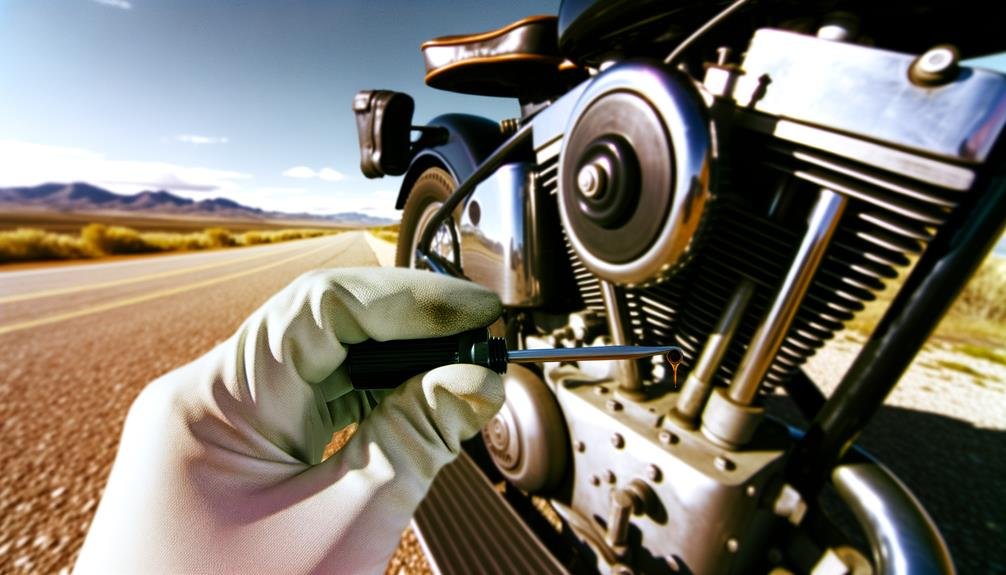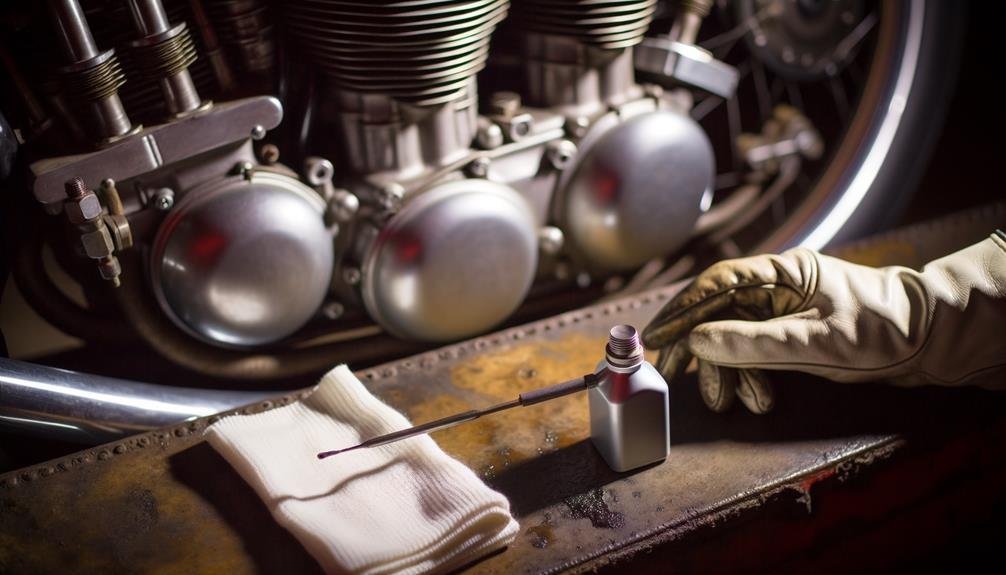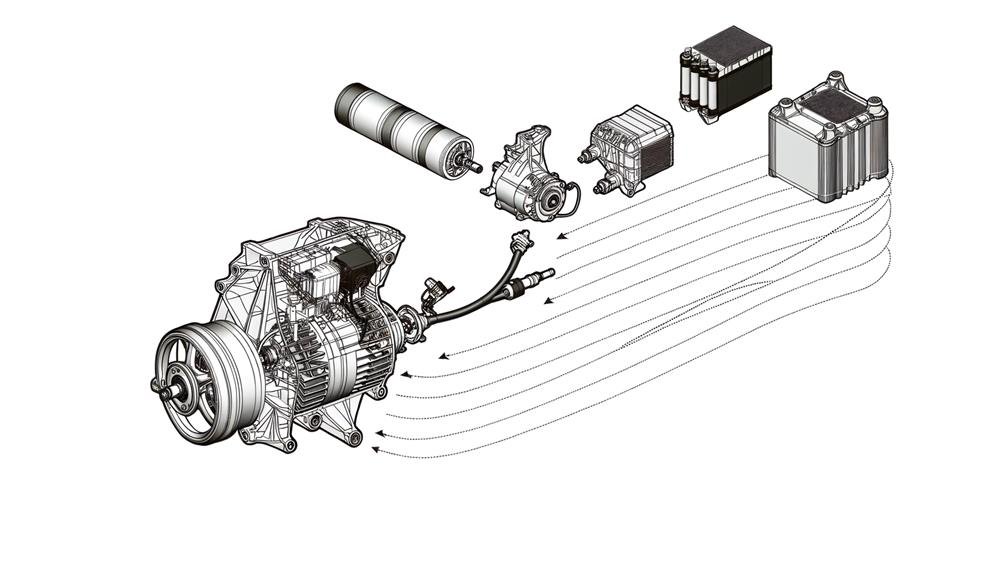Charles Miller is a veteran bike enthusiast with over 12 years of experience dealing with bikes as a mechanic. Despite immense love and expertise for...
Did you know that nearly 70% of motorcycle owners perform their own maintenance tasks? Checking the primary oil on a Harley Davidson is a key part of this routine. We'll guide you through the process, making it as simple as possible.
It's not only about saving money on mechanic fees, but also about understanding your machine better. However, there's a catch. If you don't do it right, you might end up causing more harm than good.
So, why not stick around to find out how to do it the right way?
- Key Takeaways
- Understanding Primary Oil Importance
- Required Tools for Oil Check
- Preparing Your Harley for Inspection
- Locating the Oil Dipstick
- Steps for Checking Oil Level
- Recognizing Common Inspection Mistakes
- Interpreting Oil Level Indications
- Timing for Oil Changes
- Best Practices for Oil Maintenance
- Frequently Asked Questions
- Conclusion
Key Takeaways
- Regularly checking and maintaining the primary oil level is crucial for the optimal performance and longevity of a Harley Davidson motorcycle.
- Neglecting primary oil maintenance can lead to unnecessary wear and tear, costly repairs, and potential breakdowns.
- Using the correct oil type and viscosity, following the manufacturer's maintenance schedule, and addressing oil leaks are important for proper primary oil maintenance.
- Proper primary oil maintenance provides benefits such as reduced friction and wear, extended powertrain lifespan, improved system efficiency, and increased resale value.
Understanding Primary Oil Importance
Understanding the importance of primary oil in your Harley Davidson is absolutely vital for maintaining a healthy powertrain. A lack of proper lubrication can significantly increase friction and wear on the primary chain and clutch components. We can't stress enough the significance of regularly checking the primary oil level.
It's not just about keeping your bike running smoothly; it's about extending the lifespan of the heart of your Harley, the powertrain.
Insufficient oil can be detrimental, leading to unnecessary wear and tear. The dire consequences of neglecting to check primary oil can be costly repairs and even potential breakdowns. We know you don't want that.
We're all part of the Harley family, and we want to keep our bikes on the road, not in the shop.
Required Tools for Oil Check
Before we proceed with the oil check, let's gather the essential tools and understand their usage.
We'll need:
- An Allen wrench set for removing the inspection cover
- A funnel and primary oil for topping off if necessary
- A drain pan for any excess
- Shop towels for clean up
These tools will ensure a smooth and efficient oil check, keeping our Harley Davidson in top shape.
Gathering Essential Tools
Armed with an Allen wrench set, a funnel, a drain pan, shop towels or clean rags, and primary oil, we're ready to tackle the task of checking the primary oil on a Harley Davidson.
In addition to these, you'll also need a socket and socket wrench, vital tools for removing the drain plug. The gathering of these essential tools is a significant step in ensuring a smooth and successful oil check.
We understand the importance of preparation and precision, especially when dealing with a machine as revered as a Harley Davidson. With the correct tools at hand, we're not just checking the primary oil, but demonstrating our commitment to maintaining the optimal performance of our beloved bikes.
Understanding Tool Usage
Now that we've assembled our toolkit, let's delve into how each item contributes to the task of checking the primary oil on your Harley Davidson. Understanding tool usage is key to performing this procedure seamlessly.
Your Allen wrench set is for removing the inspection cover. A socket wrench is used to loosen the drain plug, allowing the primary oil to flow into the drain pan. Shop towels or clean rags are useful for cleaning any spills that might occur during the process.
Here's a simple breakdown:
| Tool | Use |
|---|---|
| Allen Wrench Set | Removing the inspection cover |
| Socket Wrench | Loosening the drain plug |
| Drain Pan | Catching the draining oil |
| Shop Towels/Rags | Cleaning spills |
Preparing Your Harley for Inspection

To ensure an accurate oil level reading, we'll first park the Harley on a level surface with ample lighting, making sure the engine is off and cool to the touch. This initial step in preparing your Harley for inspection is crucial to avoid any burns and for safety purposes.
Next, we need to check that the bike is upright. This is important because an angled bike can lead to a false reading. After ensuring that the Harley is upright, we'll carefully reinstall the cover, checking for any oil leaks that could indicate a problem.
Now we're ready to get hands-on. Using an Allen wrench, we'll remove the inspection cover screws to check the primary oil inside the Harley Davidson primary case. It's vital to be meticulous here, as missing this step could lead to engine problems down the line.
After confirming the oil level, we might need to add or drain oil as necessary. We need to be cautious not to overfill, as this can also cause engine issues.
The final step is to clean any dirt or debris from the inspection cover area, ensuring the Harley is primed and ready for its next ride.
Locating the Oil Dipstick
Let's get straight to the point – locating the oil dipstick on your Harley Davidson.
It's typically found on the left side of the bike, near the rear of the primary cover.
Once we've identified it, we'll move on to accessing the dipstick for an accurate oil check.
Identifying the Dipstick
On the right side of your Harley Davidson's engine, near the primary case, you'll typically find the oil dipstick sporting a T-shaped handle. This crucial tool allows you to check your primary oil level efficiently. It's important to familiarize yourself with its location and appearance.
Identifying the oil dipstick:
- Note its T-shaped handle.
- Recognize its typical location on the right side of the engine.
Sometimes, the dipstick may be integrated into the primary chaincase cover. If you're unsure, check your owners manual for the exact dipstick location on your specific model.
Keep in mind, checking the primary oil regularly is a key maintenance step for your Harley. It's all about belonging to a community of responsible and knowledgeable riders.
Accessing the Dipstick
In order to access the dipstick on your Harley Davidson, you'll first need to locate it on the primary chaincase cover, typically identifiable by a 'Primary' or 'Oil' label and a T-shaped handle for easy grip and removal.
The dipstick is the key to check the primary oil on your Harley Davidson. Knowing its location is crucial, as it's your gateway to assess the oil level. While its placement is generally consistent, we strongly advise consulting your bike's manual for precision, as models may vary slightly.
Once located, simply pull out the dipstick. This action will grant you immediate access to your oil level, ensuring your Harley's optimal performance.
Steps for Checking Oil Level

To check the primary oil level on a Harley Davidson, we first need to remove the derby cover retaining screws for access. This process can be a bit technical, but with our guidance, you'll feel like a seasoned pro. It's crucial to check your owner's manual for specific instructions tailored to your bike model.
Here are the general steps for checking oil level:
- Stand the bike upright to ensure an accurate measurement. This isn't just a suggestion, it's necessary for precision.
- If you're doing this alone, use a motorcycle lift to secure the bike.
- If you have a buddy to help, they can hold the bike steady.
- Look at the oil's position in relation to the clutch shell.
- The oil should just be touching the outside diameter of the clutch shell.
- Some manuals suggest measuring 2-3/4 down from the clutch center.
Recognizing Common Inspection Mistakes
As we dive into common inspection mistakes, it's crucial to remember that even minor oversights can lead to significant issues with your Harley Davidson's primary oil system. When you check primary oil on Harley Davidson, one common mistake is forgetting to stand the bike upright. This can result in a false low oil level reading, potentially leading you to overfill the primary with oil.
Overfilling can, in turn, cause excessive heat and potential damage to the engine. Another misstep is neglecting to clean the drain plug properly before reinstallation, which can cause oil leaks and spillage.
| Common Mistake | Potential Consequence |
|---|---|
| Not standing bike upright when checking oil | False low oil level reading |
| Overfilling primary with oil | Excessive heat, potential engine damage |
| Neglecting to clean drain plug before reinstallation | Leaks, oil spillage |
| Not following manufacturer's maintenance schedule | Potential primary oil system issues |
| Using incorrect oil type/viscosity | Impedes performance, reduces system longevity |
Failing to follow the manufacturer's recommended maintenance schedule or using the wrong type of oil can also create problems. These mistakes might seem minor, but they can significantly impact the longevity and performance of your primary oil system.
Interpreting Oil Level Indications

While keeping these common mistakes in mind, let's shift our focus to understanding how to interpret oil level indications accurately on your Harley Davidson. Checking the primary oil on Harley isn't just about getting the right quantity; it's also about interpreting the oil level indications correctly.
To ensure that you're on the right track, always check your owner's manual. It contains detailed instructions and illustrations that are specific to your model. This is critical, as not all Harleys are the same.
Some manuals suggest measuring 2-3/4 inches down from the clutch center to determine the oil level. Others may have different instructions.
Use the correct method to measure the oil level. The oil level should just touch the outside diameter of the clutch shell. It's recommended to use a tape measure for accurate measurement and avoid guesswork.
Timing for Oil Changes
Let's dive into the crucial topic of when exactly you should be changing your Harley's primary oil for optimal performance and longevity. If you're asking when to be changing the primary oil, the answer is not one-size-fits-all. You should always check your owners manual for the manufacturer's recommendation. If you can't find it, we've got some general guidelines for you.
For a Harley, the primary oil should generally be changed every 2500 to 3000 miles. However, some models might allow you to push it to 5000 miles, or even 10000 miles in certain conditions. Here's a handy table to guide you:
| Type of Oil | Ideal Mileage | Max Mileage |
|---|---|---|
| Regular Oil | 2500-3000 miles | 5000 miles |
| Semi-Synthetic Oil | 5000-6000 miles | – |
| Fully Synthetic Oil | 7000-8000 miles | 10000 miles |
Best Practices for Oil Maintenance

Now that we've established when to change your primary oil, it's crucial to understand the best practices for oil maintenance to ensure your Harley Davidson remains in optimal condition. Regular maintenance isn't only about when to change the primary oil, but also about how to do it correctly.
To get the best out of your bike, here are some steps we've established:
- Always check your owner's manual. It contains detailed instructions tailored to your specific model. This is your first stop for any maintenance task.
- Understand the specifications: Get to know the type and grade of oil recommended by Harley Davidson. Don't compromise on these.
- Follow the maintenance schedule: This is crucial to keep your bike running smoothly. Stick to the timelines given.
- Change the primary oil regularly. This is a basic maintenance task, but it's crucial.
- Use the right tools: Invest in a good quality oil filter wrench and oil catch pan.
- Dispose of used oil responsibly: Remember, we're part of a larger community, and we need to protect our environment.
Frequently Asked Questions
How Do You Measure Harley Primary Oil?
We're measuring Harley's primary oil by removing the derby cover, standing the bike upright, and observing the oil level. It's crucial to use the right oil type per Harley's specifications for proper maintenance.
How Often Should You Change Primary Oil in Harley?
We'd typically change the primary oil in our Harley every 5,000 miles. However, oil quality indicators and the Harley maintenance schedule may require more frequent changes. Primary oil varieties also affect change intervals.
How Many Quarts of Oil Does a Harley Primary Take?
We're often asked about primary maintenance and oil brands for Harley longevity. Most Harleys take about one quart of primary oil. It's essential to not overfill to prevent engine damage. Keep it at clutch spring's bottom.
How Do You Check Transmission Fluid on a Harley?
"We're checking the transmission fluid on our Harley by ensuring it's warmed up. We'll remove the fill plug, wipe it clean, and reinsert it. Then, we'll remove it again to verify the fluid's at the correct level."
Conclusion
So there you have it, folks! We've navigated the rivets and gears, and discovered the secret to maintaining our Harley's health – a proper primary oil check.
Remember, it's no rocket science, but it does require attention to detail. Keep your Harley purring like a kitten from the roaring 20s, and you'll enjoy smooth sailing down the highway.
Remember, a stitch in time saves nine, so keep your oil in check and ride on!

Charles Miller is a veteran bike enthusiast with over 12 years of experience dealing with bikes as a mechanic. Despite immense love and expertise for his Tacoma, he rides his Trek Ebike more. Anytime you meet him, you’ll either hear him talking about Bikes, or writing about all things bikes and cars on this blog.
More Posts


